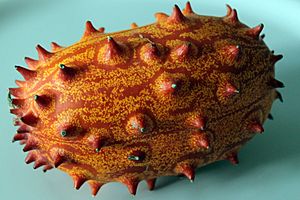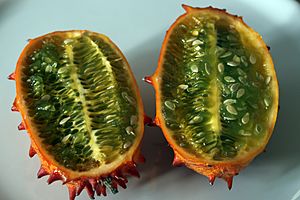Kiwano facts for kids
Quick facts for kids Horned melon |
|
|---|---|
 |
|
| Cucumis metuliferus fruit | |
 |
|
| Scientific classification | |
| Genus: |
Cucumis
|
| Species: |
metuliferus
|
Kiwano (Cucumis metuliferus), also known as horned melon or jelly melon, is a sweet tropical fruit. It gets its name from its spiky, horn-like skin. Inside, it has a jelly-like pulp with many edible seeds. This unique fruit is a member of the cucumber and melon family.
Contents
What is Kiwano?
Kiwano is a fascinating fruit that looks like it came from another planet! It is oval-shaped and can be about 10 to 15 centimeters (4 to 6 inches) long. When it's ripe, its skin turns a bright orange or yellow color. The "horns" are actually soft spines that cover the outside.
Where Does Kiwano Grow?
This interesting fruit originally comes from the Kalahari Desert in southern Africa. It has been a food source for people there for a very long time. Today, Kiwano is grown in many other parts of the world. You can find farms growing it in places like New Zealand, Australia, and parts of the United States. It needs a warm climate to grow well.
What Does Kiwano Look Like Inside?
When you cut open a Kiwano, you will see a bright green, jelly-like pulp. This pulp holds many small, flat, edible seeds. The texture is similar to a passion fruit or a pomegranate. The vibrant green color makes it a fun addition to many dishes.
How Does Kiwano Taste?
The taste of Kiwano is quite unique and can be hard to describe! Many people say it tastes like a mix of different fruits. You might notice flavors similar to banana, lime, and passion fruit. Some even say it has a hint of cucumber. The taste can vary depending on how ripe the fruit is. A very ripe Kiwano will be sweeter.
How Can You Eat Kiwano?
Kiwano is a versatile fruit that can be enjoyed in many ways. The easiest way to eat it is to cut it in half and scoop out the pulp with a spoon. You can eat the seeds along with the pulp.
- Fresh: Enjoy it plain as a healthy snack.
- In drinks: Add the pulp to smoothies, juices, or even cocktails for a tropical twist.
- In salads: Its unique flavor and texture can make fruit salads more interesting.
- Desserts: Use it as a topping for yogurt, ice cream, or other sweet treats.
Growing Kiwano
Kiwano plants are vines, similar to cucumbers or pumpkins. They need a lot of sunshine and warm temperatures to thrive. The plants produce both male and female flowers, which need to be pollinated to create fruit. After pollination, the fruit develops over several weeks. It starts green and slowly turns orange as it ripens. Farmers often grow Kiwano on trellises or supports. This keeps the fruit off the ground and helps it ripen evenly.
Nutritional Goodness
Kiwano is not just tasty; it is also good for you! It contains several important vitamins and minerals.
- Vitamin C: This vitamin helps your body fight off sickness and keeps your skin healthy.
- Vitamin A: Important for good vision and a strong immune system.
- Potassium: A mineral that helps your muscles and nerves work properly.
- Fiber: Helps with digestion and keeps your stomach feeling good.
It is also a good source of antioxidants, which are substances that protect your body's cells from damage.
Fun Facts About Kiwano
- The scientific name, Cucumis metuliferus, means "cucumber bearing small spikes."
- In some parts of Africa, it is called "gaka" or "mukakwa."
- It is sometimes used as a decorative item because of its unique appearance.
- Kiwano can be stored at room temperature for several weeks, making it easy to keep on hand.
See Also
- In Spanish: Kiwano para niños

